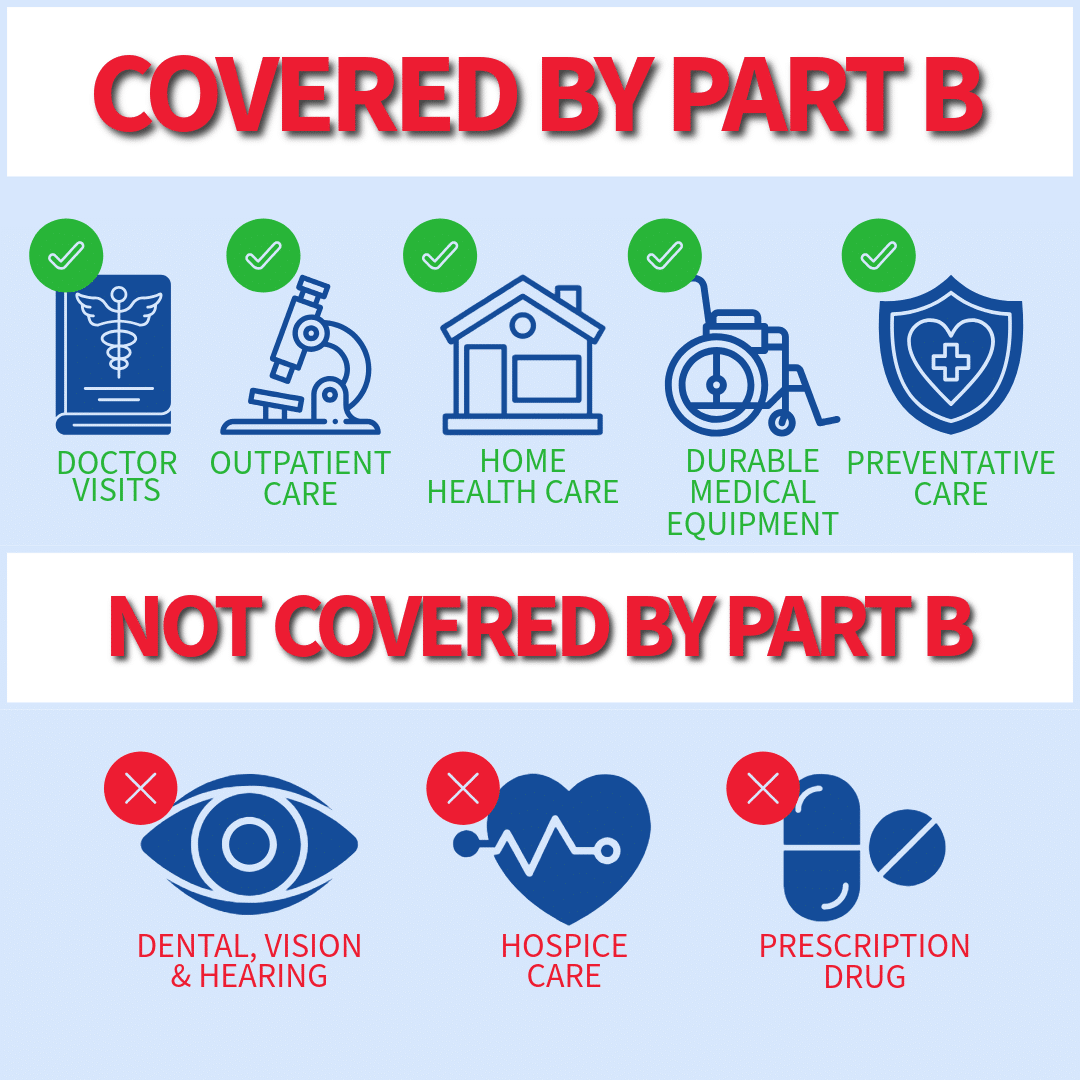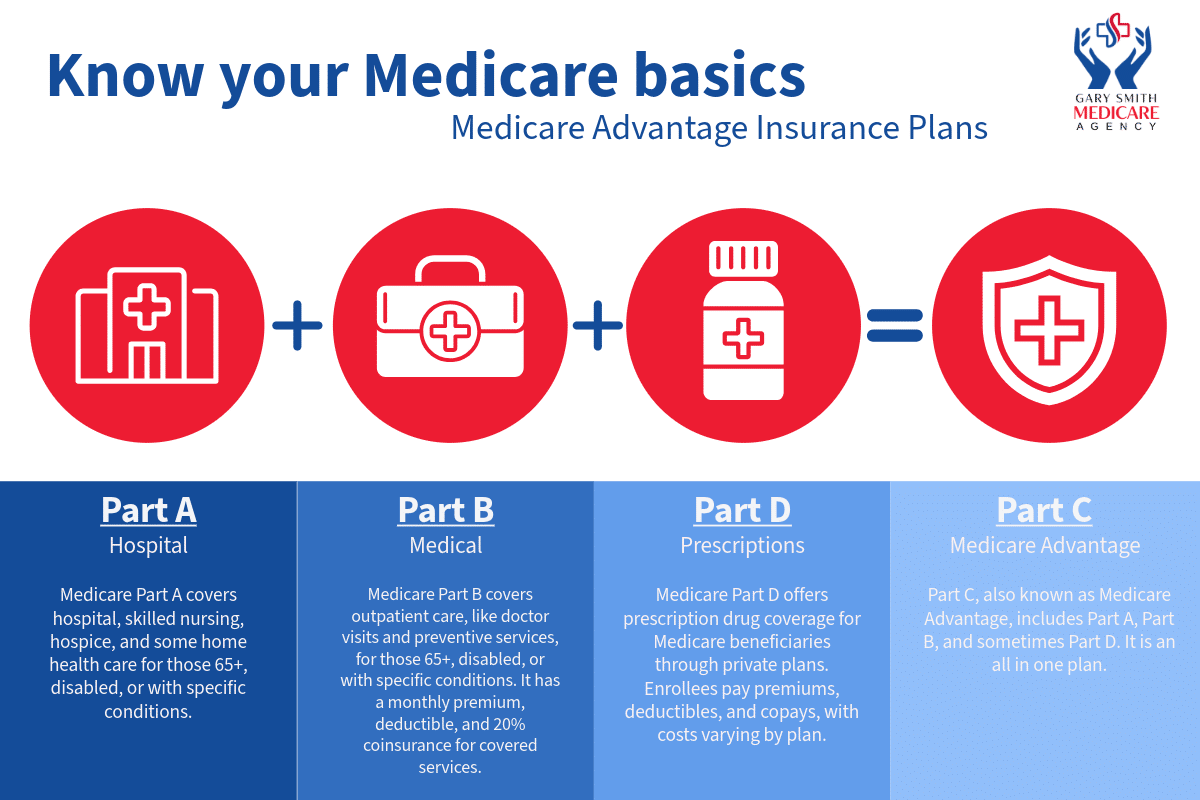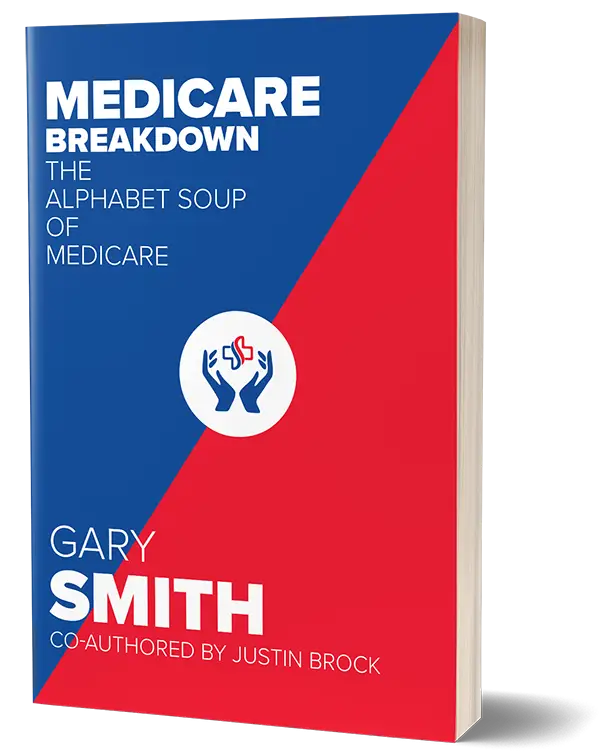Medicare Parts
A - D
What You Need to Know
Get A Free Quote
We put the CARE in Medicare!
Navigating the world of Medicare can feel a bit like standing at the edge of a vast ocean—exciting but daunting. With all the options and costs associated with this vital program, it’s essential to get a grip on what you’ll be paying. Whether you’re approaching retirement or helping a family member, understanding Medicare costs can lead to better financial decisions and a smoother healthcare experience. Let’s break it down together, shall we?
Medicare Part A
Ever wondered what happens if you land in the hospital after blowing out 65 candles? For many older adults nearing that milestone, Medicare Part A is your safety net—and it’s more crucial than you might think. As the backbone of Medicare’s hospital coverage, Part A ensures you’re not left drowning in bills when life throws a curveball, like a sudden surgery or a lengthy recovery. In this guide, we’ll unpack what Part A covers, how much it costs (spoiler: it’s often free!), and how to get it lined up before you need it. Whether you’re counting down to 65 or just planning ahead, understanding Part A is your first step to peace of mind.
What Does Medicare Part A Cover?
Medicare Part A is like the sturdy foundation of a house—it holds up your healthcare when you need hospital-level support. It’s designed to cover big-ticket items, from overnight hospital stays to specialized care after you’re discharged. Let’s break it down.
Costs and Eligibility
Now, let’s talk dollars and sense. Part A’s costs hinge on your work history, and for most, it’s a sweet deal. But there are still some out-of-pocket surprises to watch for.
Premium-Free vs. Paid Part A
Here’s the good news: if you or your spouse worked 10 years (40 quarters) and paid Medicare taxes, Part A is premium-free. That’s right—zero monthly cost. It’s like getting a VIP pass because you’ve already paid through payroll taxes. But if you didn’t hit that mark, you’ll pay up to $518 per month in 2025. Not sure? Check your Social Security statement—it’s your ticket to knowing where you stand.
Out-of-Pocket Expenses
Free premiums don’t mean free everything. In 2025, you’ll face a $1,676 deductible per hospital “benefit period” (a stay plus 60 days after). Days 1-60 are covered post-deductible, but coinsurance kicks in later—$419 per day for days 61-90. After that, it’s $838 per day from your “lifetime reserve” days. Skilled nursing? Free for 20 days, then $209.50 daily up to 100. It’s like a gym membership—entry’s free, but the extras add up.

Signing Up for Part A
Getting Part A isn’t rocket science, but timing matters. Whether it’s automatic or manual, here’s how to lock it in.
Automatic Enrollment
If you’re already collecting Social Security or Railroad Retirement benefits four months before 65, congrats—you’re auto-enrolled in Part A (and B). It’s like the government saying, “We’ve got you covered.” Your red, white, and blue Medicare card arrives, and “Hospital (Part A)” is printed right on it. For folks with disability benefits for 24 months, same deal—automatic at 65 or when eligibility hits.
Manual Sign-Up Process
Not on Social Security yet? You’ll need to roll up your sleeves. Head to SSA.gov, call 1-800-772-1213, or visit a local office. Sign up during your Initial Enrollment Period (three months before to three months after your 65th birthday) to avoid hiccups. Miss it, and you’re stuck until the General Enrollment Period (January-March), with coverage starting later. It’s like booking a flight—do it early, or pay the price in delays.
Medicare Part A is your hospital coverage cornerstone—there when you need it most, often at no monthly cost if you’ve punched the right work clock. It’s not perfect (those deductibles sting!), but it’s a lifeline for inpatient care, skilled nursing, and beyond. As you near 65, getting a grip on Part A means fewer sleepless nights worrying about “what if.” Here are three takeaways:
- Check your eligibility—confirm those 40 quarters for free coverage.
- Plan for costs—budget that $1,676 deductible and coinsurance.
- Sign up on time—automatic or manual, don’t miss your window.
With Part A in your corner, you’re ready to face 65 with confidence.

FAQs
Medicare Part B
When it comes to health insurance for older adults and those with certain disabilities, Medicare stands as a crucial pillar of support in the U.S. Among its various components, Medicare Part B plays a pivotal role—providing essential coverage for outpatient services that many rely on. So, let’s unpack the ins and outs of Medicare Part B, explore what it covers, how much it costs, and how you can navigate the enrollment process without a hitch.
What is Medicare Part B?
To put it simply, Medicare Part B is your ticket to a range of outpatient health services that help keep you healthy. Think of it as the part of Medicare that doesn’t involve inpatient hospital stays—where Part A steps in. Instead, Part B covers medically necessary services and preventive care that can catch health issues before they spiral out of control.
In contrast to Part A, which often comes premium-free if you've worked for a certain number of years, Part B does require a monthly premium. But don't let that deter you; the benefits it provides can be vital for your health and well-being.
So, how does Part B fit into the overall Medicare puzzle? Let’s delve into its coverage details next!
Coverage Provided by Medicare Part B
Here’s where it gets interesting. Medicare Part B covers a broad array of services, such as:
- Outpatient Services: From regular doctor visits to necessary surgeries that don’t require an overnight hospital stay, Part B ensures you won’t be left high and dry when you need care outside the hospital setting.
- Preventive Services: This includes services like annual wellness exams, vaccinations, and screenings for conditions like diabetes or cancer. You know what they say—an ounce of prevention is worth a pound of cure, right? Getting these services can save you from bigger, costlier health issues down the line.
- Diagnostic Tests and Lab Services: Think blood work, X-rays, and MRIs—Part B covers many diagnostic tests, as long as they’re deemed medically necessary. This means your doctor will determine if a test is required based on your health needs.
Understanding the nuances of what’s covered by Part B can help you make informed decisions about your healthcare. It’s always a good idea to double-check with your healthcare provider or Medicare to confirm coverage, as policies can change.

Costs Associated with Medicare Part B

Now, let’s talk dollars and cents. Understanding the cost structure of Medicare Part B is crucial. Here’s the breakdown:
- Monthly Premiums: Most people will pay a standard monthly premium for Part B, which is adjusted annually. For 2024, let's say the premium is around $164.90 (note that this may change). If your income is higher, you might pay more, thanks to something called the Income-Related Monthly Adjustment Amount (IRMAA).
- Deductibles: Before Medicare starts to pay its share, you’ll need to meet an annual deductible—this is the amount you pay out of pocket first. For 2024, that deductible is approximately $226.
- Coinsurance: After you meet your deductible, you typically pay 20% of the Medicare-approved amount for most doctor services and outpatient care. So, if a service costs $100, you’d pay $20, and Medicare covers the rest. It’s wise to keep track of your expenses, especially if you have multiple visits or procedures in a year.
You might wonder—are there extra costs? Yes, out-of-pocket expenses can include things like copays for specific services or costs for non-covered services, so always stay informed about what your plan entails.
Enrollment in Medicare Part B
If you've made it this far, you're probably wondering how to join the ranks of Part B beneficiaries. Here’s the lowdown on enrollment:
Key Considerations and Common Misconceptions
Before wrapping up, let’s address a few common misconceptions about Medicare Part B that might trip you up.
Navigating Medicare Part B doesn’t have to be a daunting task. With a better understanding of what’s covered, how much it costs, and how to enroll, you’ll be well on your way to making informed decisions about your health care.
Whether you’re approaching that magical age of 65 or figuring out how Medicare fits with your current insurance, being proactive about your health coverage is essential. If you’re ever unsure, don’t hesitate to reach out to Medicare or a trusted advisor. After all, your health is your greatest asset—make sure it’s protected!
In summary, Medicare Part B is a critical part of the Medicare program that offers valuable protection for outpatient care and preventive services. Knowing how to navigate its coverage, costs, and enrollment helps ensure you have the support you need when it matters most. Your health journey deserves clarity and confidence, so take the next step and stay informed!
Medicare Part C
Navigating the world of healthcare can feel a bit like swimming uphill. With so many options and terms floating around, it’s easy to get overwhelmed. But fear not! Today, we’re diving into Medicare Part C, or Medicare Advantage, and breaking it down piece by piece. Whether you’re gearing up for retirement or helping someone close to you understand their options, this guide will shed light on the ins and outs of Medicare Part C.
What is Medicare Part C?
You might be wondering: What exactly is Medicare Part C? Well, let’s clear up the confusion. Medicare Part C, also known as Medicare Advantage, is a different way of getting your Medicare benefits. Instead of the traditional Original Medicare (Part A and Part B), Part C bundles these benefits—often along with extra perks. Think of it as a one-stop shop for your healthcare needs.
Medicare Advantage plans are offered by private insurance companies approved by Medicare. These plans provide all the coverage you’d expect from Parts A and B, plus some plans throw in additional benefits that can be a real game-changer. This could include:
- Dental and vision coverage: Not something you usually think of with Original Medicare.
- Hearing aids: Helping you tune into the world around you.
- Wellness programs: A little nudge to stay active and healthy.
Who Can Enroll? Let’s Check the Eligibility Box
So, who qualifies for Medicare Part C? Here’s the scoop. You need to be:
- 65 or older: Most people become eligible when they hit this milestone.
- Younger individuals with disabilities: If you’ve been receiving Social Security disability benefits for at least 24 months, you’re in.
- People with certain health conditions: Some conditions, like end-stage renal disease (ESRD) or amyotrophic lateral sclerosis (ALS), also open the door.
Enrollment doesn’t have to be a headache. Here’s how it typically works:
- Initial Enrollment Period (IEP): This is a seven-month window that starts three months before your 65th birthday.
- Annual Open Enrollment Period (AEP): From October 15 to December 7, you can sign up for a plan, switch plans, or return to Original Medicare.
- Special Enrollment Periods (SEPs): If you experience certain life events—like moving or losing other healthcare coverage—you might qualify for a special enrollment window.
It’s crucial to mark these dates on your calendar! Missing them could mean waiting another year for your chance to enroll.

Benefits You Didn’t Know You Needed

One of the biggest draws of Medicare Part C is the extra benefits. Let's call it the “cherry on top” of your healthcare sundae. Beyond the standard coverage, many Medicare Advantage plans offer things like:
- Gym memberships: Yes, you could get access to your local fitness center and feel fabulous.
- Transportation assistance: For those tricky trips to appointments—bye-bye, scheduling woes!
- Meal delivery services: Seriously, a little help with meals can make life so much easier.
And we can’t forget about cost efficiency. Many plans have lower monthly premiums than Original Medicare. Some plans even offer $0 premiums! However, there are trade-offs, like structure and flexibility in how you receive care. You might have to use a network of doctors, which can be a little limiting, but the benefits can outweigh the restrictions for many folks.
Enrollment in Medicare Part B
When considering Medicare Part C, cost is often at the forefront of most people’s minds. So, what are we looking at here?
- Monthly premiums: While some plans come with a $0 premium, others may charge up to a few hundred dollars. It really varies, so check each plan closely.
- Deductibles: The amount you need to pay out-of-pocket before your insurance kicks in can also differ. Some plans offer low or no deductibles.
- Copayments: When getting care, you might have to pay a copay—think of these as small 'thank you' notes to your providers.
Let’s consider an example. If you go to a specialist, you could have a copay of $20-$50 depending on your plan. Comparing plans is worthwhile, especially when looking at out-of-pocket maximums. With a cap on annual spending, you could protect yourself from unforeseen medical emergencies.
This table outlines some average costs associated with common Medicare Advantage plans:
| Type of Cost | Average Amount |
|---|---|
| Monthly Premium | $0 - $100 |
| Annual Deductible | $0 - $500 |
| Copayment (Specialist) | $20 - $50 |
| Out-of-Pocket Limit | $3,000 - $7,500 |
These figures are general; be sure to check specific plans for precise numbers.
Picking the Perfect Plan: Let’s Make a Choice
Now, let’s tackle the all-important question: How do you choose the right Medicare Part C plan for you? It starts with assessing your individual needs. Are there specific doctors you want to keep? Is your preferred hospital in-network with the plan? Here’s a handy checklist to help you sort through the options:
- Evaluate your healthcare needs: Look at your current health conditions, prescription drugs, and frequency of doctor visits.
- Check networks: Make sure your favorite doctor and any specialists you may need are compliant with the plan.
- Compare plans: Use resources like Medicare.gov’s Plan Finder tool. It’s user-friendly and can show comparison charts to help you see what’s best.
If this all feels a bit overwhelming, consider reaching out for some guidance. Local State Health Insurance Assistance Programs (SHIP) can offer free, personalized help without any sales pitch attached. They’re a terrific resource for those who feel a little lost in the Medicare maze.
Navigating Challenges: What to Watch Out For
While Medicare Part C comes with a lot of perks, it’s not without its hurdles. Here are a few things to keep an eye on:
- Network restrictions: Depending on the plan, some may only cover services from in-network providers. If you stray outside this network, it can cost you big time—like breaking the bank on a fancy meal that turns out to be a flop.
- Annual plan changes: Each year, your plan can change its benefits, premiums, and even provider networks. This means you’ve gotta stay vigilant and review your options before the Annual Open Enrollment Period each fall.
- Coverage gaps: While Medicare Advantage covers many bases, you still might encounter services that aren’t covered. Long-term care and certain therapy services might require additional insurance or out-of-pocket costs.
By understanding these challenges, you can prepare yourself to navigate the system but always remember: knowledge is power!
Your Medicare Part C Journey
So there you have it—a guide to Medicare Part C that’s as engaging as it is informative! This plan can serve as a powerful tool for managing your healthcare in a way that benefits you most. Remember to weigh all your options carefully, take the time to compare plans, and ask questions when in doubt.
Deciding on the right Medicare Advantage plan isn’t just about filling a checkbox; it’s about ensuring your healthcare aligns with your needs and lifestyle. So take that next step: research, ask around, and empower yourself to make informed decisions.
Now, isn’t that a more comforting thought? After all, a well-informed choice can make all the difference in your journey through healthcare. Remember, you’re not alone in this—you’ve got the resources and support to make the right decisions.
Summary of Key Points:
- Medicare Part C (Medicare Advantage) bundles Medicare benefits with added perks.
- Eligibility includes people aged 65+, certain disabilities, and specific health conditions.
- Plans can offer additional benefits like vision, dental, and gym memberships.
- Cost considerations include premiums, deductibles, and out-of-pocket limits.
- Choosing the right plan requires understanding personal healthcare needs and comparing options.
Keep these details in mind as you chart your course through Medicare. Good luck, and take care!
Medicare Part D
Medicare Part D can feel like a tangled web of choices and rules, but understanding it is more important than ever. For millions of seniors and eligible individuals, this program promises help with often skyrocketing prescription drug costs, offering a safety net that can make a big difference in daily life. Let’s unravel what Medicare Part D is all about, how it works, and what you need to know to make it work for you.
What is Medicare Part D?
So, what exactly is Medicare Part D? Basically, it's a federal program designed to help with the cost of prescription drugs. This might sound straightforward, but it’s built on a foundation of options and decisions that can be overwhelming. Think of it as just one piece of the Medicare puzzle, which itself includes Parts A, B, and D. While Part A covers hospital stays and Part B takes care of outpatient services, Part D is where the rubber meets the road for your medicine cabinet.
To qualify, you typically need to be 65 years old or older, or you might be younger but have a specific disability. The eligibility criteria seem simple, which is good news, but here’s where it can get tricky: signing up. You have specific times when you can enroll, and if you miss those windows, you might face penalties later on.
How Medicare Part D Works
Let's break down how Part D operates. First off, there are enrollment periods – think of them like golden windows of opportunity. You've got your Initial Enrollment Period (IEP), which is when you can first sign up when you turn 65. If you miss that, there are other chances, like the Open Enrollment Period every fall. If you're not careful, though, this can lead to some lingering regrets, like paying late fees.
Next up, you'll encounter something called a formulary. This is essentially a list of drugs that each plan covers. You’ll want to take a good look at this list because it can vary widely between plans. Imagine you have a preferred medication, but it's not covered by your chosen plan. That could mean serious out-of-pocket expenses. So, what’s the best way to avoid this pitfall? Research, research, research!
Now, let’s talk dollars and cents. Costs associated with Part D include premiums, deductibles, and copays. Premiums are monthly fees you pay to stay enrolled in the program. The deductible is the amount you have to spend before your coverage kicks in. After this, you’ll share the costs of your prescriptions via copayments, which are usually lower than retail prices. But be wary; some folks hit a financial wall called the "coverage gap" or "donut hole," where your costs can temporarily skyrocket.

Choosing a Medicare Part D Plan

Choosing the right Part D plan might feel like a second job, but it’s crucial to get it right. You can’t just go with the first one you find or choose based on branding alone – that’s a recipe for disaster. Start by considering your personal prescription needs. What medications are you currently taking? Are they covered by the plans on your radar?
If you’re worried about feeling lost in this process, you’re not alone. Many beneficiaries find the variety of options overwhelming. Here's a tip: the Medicare Plan Finder tool is your new best friend. This resource helps you sort through plans based on your medications, pharmacy preferences, and budget. And if you still feel unsure, don’t hesitate to reach out to your local State Health Insurance Assistance Programs (SHIPs). They offer free, personalized assistance that can help you find clarity amid all the noise.
Financial Considerations
Now, we’ve got to talk money. Medicare Part D can have significant cost implications, and trust me, it’s worth understanding how this all breaks down. Average premiums vary, but it’s important to budget for these monthly fees as part of your overall healthcare expenses.
When planning your budget, factor in the potential costs for your medications. Some medications can break the bank, while others are surprisingly affordable. The means-tested Low-Income Subsidy (LIS), also known as Extra Help, can potentially save you a lot of cash if you qualify. This program reduces premiums and out-of-pocket costs, making it a game changer for many.
Challenges & Limitations of Medicare Part D
Even though Medicare Part D is a lifeline for many, it's not without its challenges. One major hurdle is the sheer complexity of the choices out there. With dozens of different plans, each with different costs and coverage options, it’s easy to feel overwhelmed. Look, you might find yourself wishing for a simple checklist that presents everything in black and white, but of course, life isn't that easy.
Charging through the limitations, some medications may simply not be covered under your plan, despite being crucial for your health. This variability can lead to frustration, especially when you have to switch medications or pay entirely out of pocket. Plus, keep an eye on those formularies; they can change from year to year, possibly leaving you scrambling to find alternatives.
Recent Changes & Future Directions
Just like everything else in healthcare, Medicare Part D is evolving. Recent legislative changes have aimed to address rising drug costs, which is a hot topic for many these days. Policymakers are talking about proposals that could expand coverage and improve affordability. It’s definitely a space to watch—changes could impact what you pay for your medications and how you access them.
As we look ahead, there's a growing push for transparency in drug pricing as well. Imagine a world where you can see the costs of your medications right up front, making it not only easier to plan but also easier to challenge excessive pricing.
Your Steps toward Medicare Part D
In wrapping things up, understanding Medicare Part D is vital for anyone eligible. The landscape of prescription drug coverage is complex but so important, especially in today’s world where out-of-pocket costs can feel overwhelming. By staying informed, comparing options, and seeking help when you need it, you can navigate this maze much more effectively.
Remember, you don’t have to tackle this alone. Whether it’s reaching out to a friend or a professional advisor, your health and finances deserve proactive management. So, take a moment—evaluate your options, weigh your needs, and make sure you’re set up for success in managing your prescription drug coverage.
Additional Resources
Need more information? Here are some helpful links:
- Medicare Official Website
- State Health Insurance Assistance Programs (SHIPs)
- Medicare Plan Finder Tool
Staying informed can lead to better choices, and that’s a sound investment in your health!



